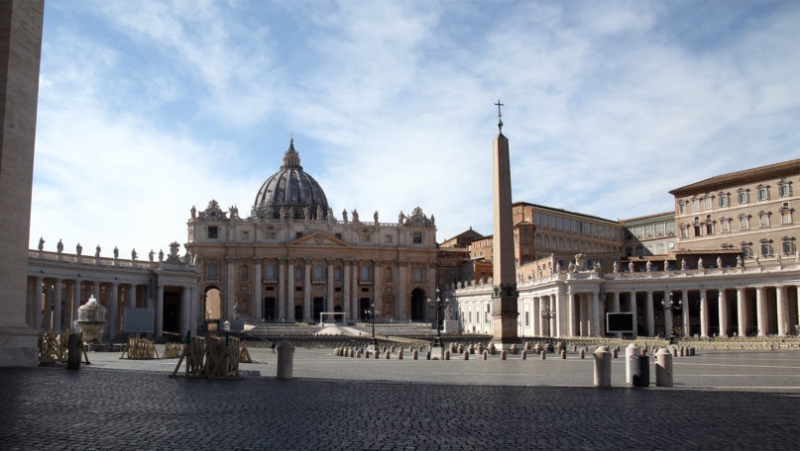
CLAIRE GIANGRAVÉ, of Religion News Service, reports from Rome on how life there has changed…
Vatican City
RNS
Since the fall of the fascist dictator Mussolini, the state in Italy has been a rather nebulous entity. Governments rise and fall — 61 since the end of the Second World War, but who’s counting? – yet things have kept on just fine.
Where the state was for the most part invisible, the Catholic Church has been the real, tangible reality in the country and nowhere more than Rome, where you can pass a dozen priests before seeing a single policeman.
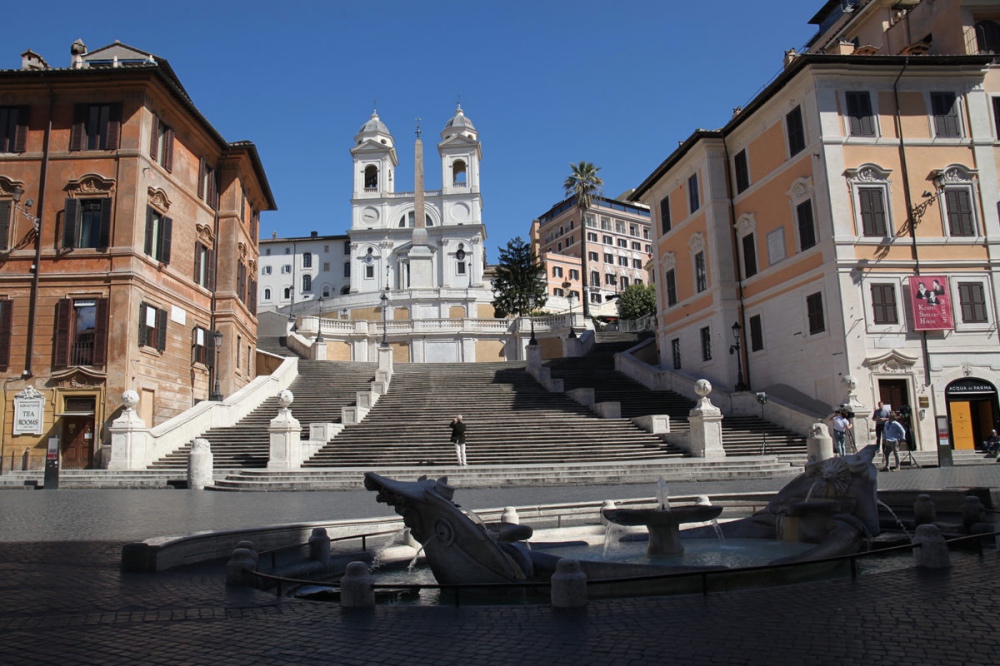
A single individual, centre, takes a photo at Rome’s famous Spanish Steps on 12th March, as a camera crew works on the right. PICTURE: Federico Manzoni
But since the Italian government imposed drastic measures to contain the spread of the coronavirus on Monday, the situation has flipped.
Overnight, the state has made itself visible in full force while the Catholic Church is nowhere to be found.
The homeless are especially struggling. Police attempt to move them from their usual haunts. The ones I saw this morning seemed to respond with a ‘rage against the machine’ mentality, yelling at anyone who came close or, in two cases, even purposefully coughing in the direction of unwanted strangers.
All of a sudden, I found myself printing government papers detailing my personal information and explaining my reason for leaving the house. Many friends and family discouraged me from going out, some even suggesting I was betraying my civic duty by exposing myself to the virus that has already claimed more than 800 victims from the over 10,000 infected in Italy.
In my reporting around the deserted city of Rome – the emptiness made even more striking by the sunny days of spring that would usually have drawn crowds to the piazzas and parks – I was stopped by the police three times. They asked for my documents and, after I explained that I am a journalist, allowed me to go on my way. Others were not so lucky. “Don’t stay out too long!” a policeman yelled to a young woman carrying a small pharmacy bag, who nodded before scurrying along.
The homeless are especially struggling. Police attempt to move them from their usual haunts. The ones I saw this morning seemed to respond with a “rage against the machine” mentality, yelling at anyone who came close or, in two cases, even purposefully coughing in the direction of unwanted strangers.
Only pharmacies and grocery stores remain open, with long lines to enter, while everyone else has been forced to close up shop. (People in queues must stand three feet apart to maintain social distancing.) Public transportation is still functioning, but the barrier surrounding the driver is now sealed. Policemen and carabinieri are present at all intersections, and even a few military trucks patrol the Eternal City.
Italian Premier Giuseppe Conte brought the hammer down on Monday, making all of Italy a “red zone” and applying the world’s harshest containment measures so far outside of China. The motto is #Iorestoacasa, meaning “I stay home,” which has been repeated by celebrities on social media and placidly accepted by Italian citizens.
After all, a widely circulated meme says, our grandparents were asked to risk their lives in a global war. We have merely been asked to stay home.
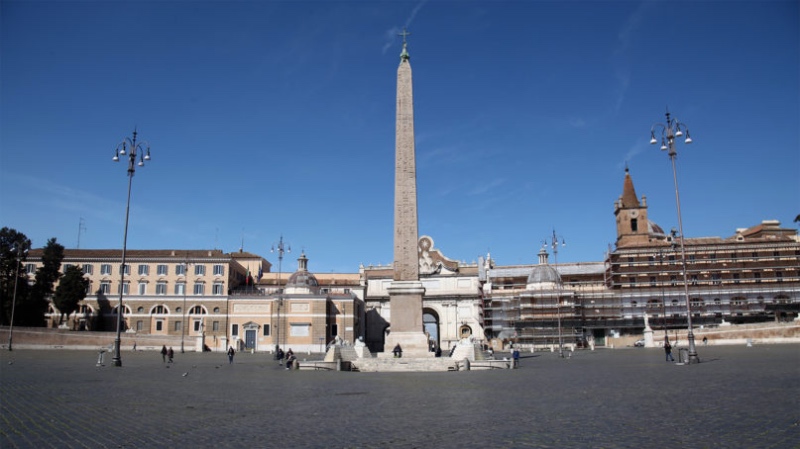
A mostly deserted Piazza del Popolo on 12th March, in Rome. PICTURE: Federico Manzoni
Even the statue of Pasquino, located not too far from the Pantheon and usually covered with notes in Roman dialect criticising governments and clergy, seems to be at a loss for words. The marble sentinel that’s for centuries voiced the Roman malcontent has fallen silent.
Yet no silence is more striking than that of the Italian Roman Catholic clergy. Masses have been banned in the entire country, baptismal fonts are drained and even confessionals were empty in the numerous churches I visited. A few people braved the virus to pray in the pews, dutifully kneeling three feet apart, of course. Only members of the clergy have access to St Peter’s Basilica and square. As of Wednesday night, all churches are being closed in Italy.
As I crossed the Tiber away from the Vatican, I saw an elderly man clutching a rosary and, judging by the muttering of his lips, he seemed to be praying. I called to him, but he seemed to quicken his step. I spotted a red sliver under his hat. “Your Eminence!” I said, using the formal address reserved for cardinals. He turned.
“I’m a journalist and I wanted to ask you about faith in these tryi…” I started, but the cardinal had already rushed away.

An empty St Peter’s Square in Vatican City on 12th March, in Rome. PICTURE: Federico Manzoni
Two nuns wearing masks and another near a bus stop also dismissed me with a firm “No.” The numerous clergy members who are a fixture of the Roman streets have become scarce, and those who are still around are not in a chatty mood.
Serena Coronari, a young woman who only recently found her faith again, managed to attend one of the last Masses before the ban went into effect. She’s resigned now to watching Mass on television but told me on the phone Wednesday that she views this as a moment for “recollection.”
“I have adopted the habit of praying when I am on my scooter or when I listen to music,” she said, adding that part of being Catholic means not harming your neighbor and therefore following the law.
“Even though it’s a Catholic congregation,” she added, “it doesn’t mean that we don’t have to listen to the science.”
She said confessions remain open in her church in the north area of Rome and there is a carefully distanced line to meet with the Salesian priests who administer there.
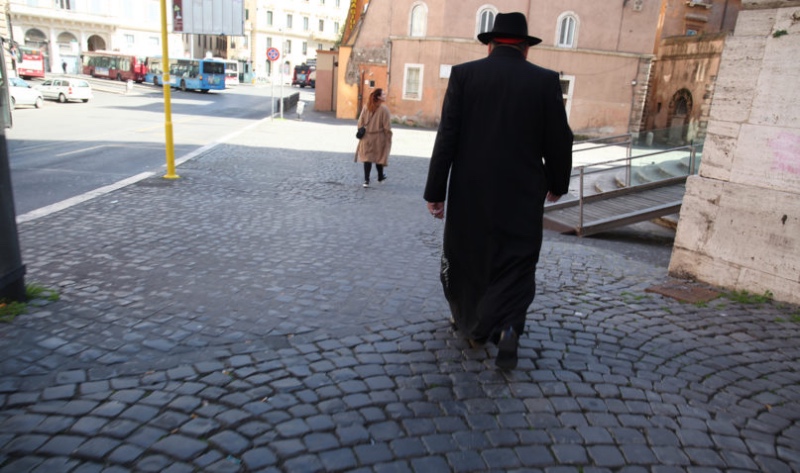
A solitary Roman Catholic cardinal walks in Rome on 12th March. PICTURE: Federico Manzoni
“Render unto Caesar” seems to be the approach taken by the Catholic Church in Italy, quoting Italian regulations in its documents and dispositions. Even Pope Francis has called faithful “to a strong sense of responsibility and collaboration with the competent authorities,” in a letter announcing the Via Crucis meditations on Monday.
Of course, the Catholic Church continues to be active in the field of charity and assistance to the sick. The Catholic non-profit charity Caritas and the movement of St Egidio have been active since the beginning in bringing meals and spiritual support to those in need.
The current norms are supposed to be lifted on 3rd April, only a couple days before Palm Sunday, which ushers in the Easter celebrations. A friar I met on the Roman streets didn’t seem preoccupied and rejected the notion that Easter could be postponed.
“Never,” he said, “the worst is never certain!”
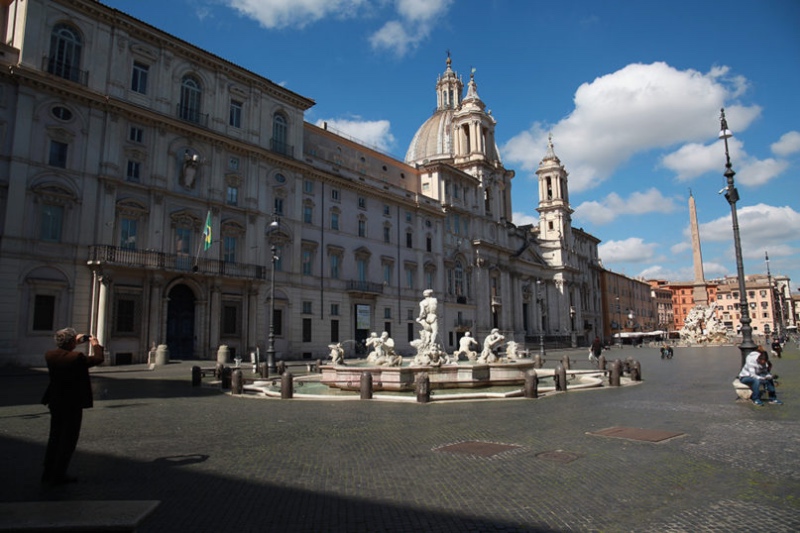
A man takes a photo, left, of a mostly deserted Piazza Navona on 12th March, in Rome. PICTURE: Federico Manzoni





